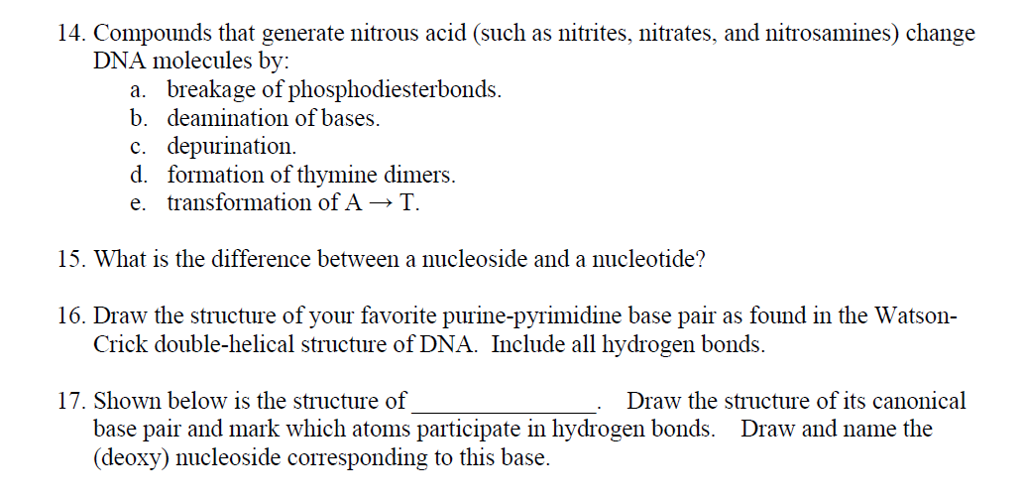Question
14. Compounds that generate nitrous acid (such as nitrites, nitrates, and nitrosamines) change DNA molecules by: a. breakage of phosphodiesterbonds. b. deamination of bases.

14. Compounds that generate nitrous acid (such as nitrites, nitrates, and nitrosamines) change DNA molecules by: a. breakage of phosphodiesterbonds. b. deamination of bases. c. depurination. d. formation of thymine dimers. e. transformation of A T. 15. What is the difference between a nucleoside and a nucleotide? 16. Draw the structure of your favorite purine-pyrimidine base pair as found in the Watson- Crick double-helical structure of DNA. Include all hydrogen bonds. 17. Shown below is the structure of _ Draw the structure of its canonical base pair and mark which atoms participate in hydrogen bonds. Draw and name the (deoxy) nucleoside corresponding to this base.
Step by Step Solution
3.39 Rating (158 Votes )
There are 3 Steps involved in it
Step: 1

Get Instant Access to Expert-Tailored Solutions
See step-by-step solutions with expert insights and AI powered tools for academic success
Step: 2

Step: 3

Ace Your Homework with AI
Get the answers you need in no time with our AI-driven, step-by-step assistance
Get StartedRecommended Textbook for
Organic Chemistry
Authors: Francis A. Carey
4th edition
0072905018, 978-0072905014
Students also viewed these Biology questions
Question
Answered: 1 week ago
Question
Answered: 1 week ago
Question
Answered: 1 week ago
Question
Answered: 1 week ago
Question
Answered: 1 week ago
Question
Answered: 1 week ago
Question
Answered: 1 week ago
Question
Answered: 1 week ago
Question
Answered: 1 week ago
Question
Answered: 1 week ago
Question
Answered: 1 week ago
Question
Answered: 1 week ago
Question
Answered: 1 week ago
Question
Answered: 1 week ago
Question
Answered: 1 week ago
Question
Answered: 1 week ago
Question
Answered: 1 week ago
Question
Answered: 1 week ago
Question
Answered: 1 week ago
Question
Answered: 1 week ago
Question
Answered: 1 week ago
Question
Answered: 1 week ago
View Answer in SolutionInn App



